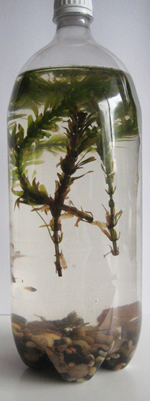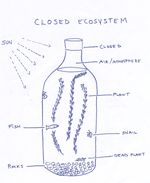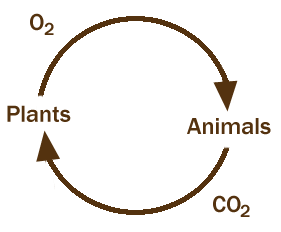Model Lesson Plan: The Carbon Cycle
One of the most compelling ways to teach students about the carbon cycle is to have them observe it first-hand. Students learn better and are motivated by seeing oxygen bubbles on plants and snails and microorganisms thriving in a closed ecosystem.
The lesson plan below is appropriate for middle and high school students. Some adaptation may be necessary depending on your students and instructional goals. If time is available, students can also build the ecosystems as part of a class activity. Any comments or questions are welcome and can be sent to wbreslyn@umd.edu.
Teacher Information
Preparation
- Review the lesson plan.
- Prepare the model "bottle ecosystem".
Note that this lesson will need to be adapted depending on the ability level of students, prior learning, and language skills. The lesson plan here is for higher ability students. You may consider breaking the lesson into two days for lower ability students. This might include providing time to make observations of bottle ecosystems in small groups, building vocabulary, and more time for each section of the lesson plan.
Equipment
- Candle, Matches, and Beaker (or something to cover the candle)
- Bottle Ecosystem (bottle or jar, aquatic plant, small fish or aquatic organism, several snails)
Teacher Materials
- Teacher Material 1: Sample Diagram of Bottle Ecosystem
- Teacher Material 2: Building a Bottle Ecosystem
Learning Objectives
- After examining a bottle ecosystem, students will list five elements that are necessary for a closed ecosystem to function.
- Individually, students will create and label a diagram of the flow of carbon and oxygen in a closed ecosystem.
- In pairs, students will use their knowledge of the flow of carbon and oxygen in closed ecosystems to accurately predict what will happen to a bottle ecosystem when five different components are altered.
Motivation (10 min)
Students view a burning candle and bottle ecosystem to activate their prior knowledge of gases and cycling of gases within ecosystems.
- To engage students in a discussion about oxygen and carbon dioxide gases, ask students what a candle needs to burn. Write their ideas on the board. It is likely that someone will mention oxygen (or air).
- Ask students to predict what will happen when you cover the candle with a beaker or jar. Most will predict that it will go out.
Note: Many students don't conceptualize gases as being matter. This demo should help establish that there is something in air that has an effect on processes like burning.
- Write the following three questions on the board:
- Why did the candle go out?
- What would happen if you were in a closed container?
- Why don't we run out of oxygen on the earth? Where does O2 come from?
- After answering the questions, present the model ecosystem to students. Explain that a model is a tool scientists use to test their ideas and answer questions. Models are meant to be simpler and allow scientists to make changes and see what happens. In this case, the bottle ecosystem is a model of earth.
- Ask students how the bottle ecosystem is a model of the earth.
They might say...
- There is water, air, life.
- Light from outside enters the bottle like the sun shining on earth.
- No matter leaves or enters the system, just light.
- Ask how it is different. They might say...
- It's smaller.
- There aren't many different animals or plants.
- There aren't many different habitats.
- Tell students that the class will be using the model ecosystem to help understand how animals, plants, carbon dioxide, and oxygen gases on earth form the carbon cycle.
You may want to walk around the room to be sure that all students have a chance to see the ecosystem. During this time, you can encourage students to ask questions. They will likely want to know how long the fish or snails have been in the bottle, why they don't die without air, etc.
Information (15 min)
 |
| Larger image available in Teacher Materials. |
Students have now seen a closed ecosystem and have made a connection between oxygen and living organisms. They will also likely have questions about how the organisms can survive in the closed ecosystem without a source of oxygen. Students will now learn the appropriate terms relating to ecosystems and the carbon cycle. They will also develop an understanding of the roles of different living and non-living components of the ecosystem.
- Draw a large outline of the bottle ecosystem on the board. Have students copy the drawing in their notes. As they copy the diagram ask for volunteers to come to the board and add a component (snail, plants, fish, soil, rocks, air pocket, etc.). See diagram.
- For each element, draw an arrow and label the component. Be sure that all of the elements are listed as shown in the diagram to the left. Have students add this information to their notes.
- With students' input, add information about CO2 and O2 under Plant, Fish, and Snail in the diagram. For example, under Plant, write "Uses CO2, Produces O2".
The goal is to provide an opportunity to use the information, along with discussion so far about the model ecosystem, to organize their thinking into a diagram of the carbon cycle.
Practice (5 min)
In order for students to establish the relationships between animals, plants, oxygen, and carbon dioxide in the bottle ecosystem, students will now complete a simple diagram of the carbon and oxygen cycle.
Have students use the information to create a diagram showing how plants and animals use CO2 and O2 based on the diagram and information from class. You can provide a skeleton diagram (shown at right) if students need scaffolding or if time is an issue. The diagram will become part of their notes. You may want to mention how the candle needs oxygen to burn and give off energy just like the snails and fish need oxygen to generate energy.
Simple Diagram of Carbon Cycle - Once students have created their diagram, ask volunteers to fill in a skeleton diagram on the board. If time is a concern, ask students questions and complete the diagram yourself.
- Ask students what happened to the carbon in CO2 after plants converted the CO2 to O2. They should recognize that it is now part of the plant.
Application (15 min)
Students apply their knowledge of oxygen and carbon dioxide flow in ecosystems to make predictions about what will happen to a bottle ecosystem when different components of the ecosystem are changed.
- Have students work in pairs to predict what will happen for each of the changes below. Remind them that they need to refer to what we have learned today about CO2 and O2 to support their prediction.
What happens to the ecosystem if we:
- Cover it with a blanket?
- Take away the plants?
- Take away the animals?
- Add more fish and snails?
- Add more plants?
- Circulate around the room asking questions and encouraging students to think about the information presented in class to support their predictions. You may ask them to recall earlier lessons on ecosystems and food webs.
- After five minutes, have students come back together as a group. For each question, have a pair of students explain what they think would take place. Invite other students to comment and ask questions. Students should write down what will happen for each question, and how it related to O2 and CO2, in their notes.
You may wish to have several ecosystems around the room for students to view. If there is sunlight it may be possible to see oxygen bubbles forming on aquatic plants.
Assessment
Have students complete an exit card for the question, "How is the earth a closed system?" Encourage students to look at their notes to answer the question.





